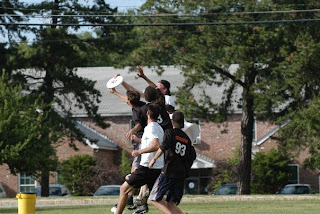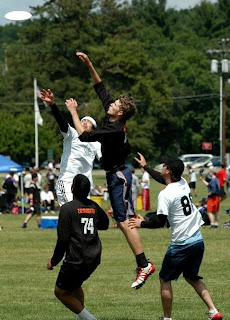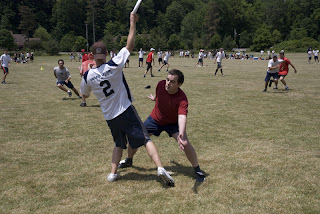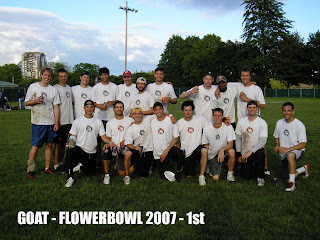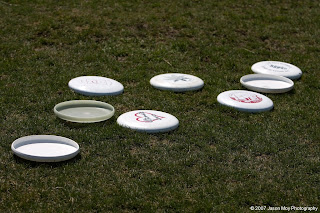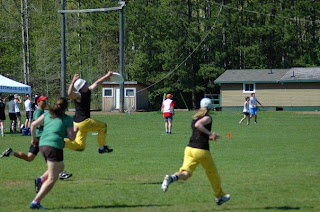This is the last part of the review of In Pursuit of Excellence: How to Win in Sport and Life Through Mental Training, Third Edition. I'll look at the last two sections of the book.
Section III of the book provides a number of methods to prepare yourself to deal with the challenges of a mental game. I'll summarize each section briefly:
- Chapter 7 - The key is getting to know yourself and how you react to situations and when you perform your best/worst. The book provides a method to focus on improving specific skills. This is a preamble for all the following chapters.
- Chapter 8 - The focus of the chapter is becoming consistent at performing well. This means focusing and refocusing after setbacks and errors to become a consistent performer. The classic focus challenge is making an error. Many people start to crumble once they make an error. Instead, react to the situation (for Ultimate this usually means play D and forget about the error), relax since it isn't the end of the world, focus on correcting the error, and encourage yourself (plus you'll get team encouragement). Another element of consistency is mood related. We all have different moods depending on a multitude of factors, but it is relatively easy to change your mood.
- Chapter 9 - The positive theme continues with the use of positive images in this chapter. This is the classic sports visualization technique where you think about yourself performing an action or task correctly. The book emphasizes what additional steps you need to take to make visualization more worth while.
- Chapter 10 - This chapter deals with what appears to be a paradox in the desire of an athlete to be relaxed and intense at the same time. Relaxation is needed both outside and inside Ultimate. You can relax in a number of ways that I won't get into. In the game, breathing, laughing, and smiling are all simple tactics to help the body relax. Intensity is the focus and exertion that you bring to the game. It's easy to have high intensity in big games with proper warm ups. The challenge is when you are tired or something isn't feeling right. In these cases we need to bring our intensity up.
- Chapter 11 - This chapter talks about distraction control. The major point is that distractions are only distractions if you let them be distractions. The more focus you have on what you are doing the less distractions there are. I've talked to lots of guys, myself included, who don't even notice a crowd in a big game. We're just focused on the game.
- Chapter 12 - One of my favourite chapters of the book and something I've discussed before on my blog (so it wasn't my idea first) is simulation. Simulation allows us to prepare for possibilities. The case study in this chapter talks about the dominant Indonesian badminton team in the 90s that used simulation in all sorts of ways.
- Chapter 13 - This is a fascinating topic that I've enjoyed in the past - the concept of Zen. Zen in relation to athletics is going into what people commonly call the zone where you just perform. There's no thinking about performance it is just being in the moment and doing. There's lots of philosophy in this section, but I think it comes down to letting our reaction or primal mind just get into the game and guide our actions.
- Chapter 14 - This is a chapter on self-hypnosis, which is a topic I've not actually looked at or explored in terms of sport. It all sounds interesting, but I'm going to leave a discussion out until I've learned more.
- Chapter 15 - This is a summary of the section. The author emphasizes that even if you are trying to improve your game it's not guaranteed that changes will happen instantly. You need to be persistent and continue to work on all facets of improving before expecting major results. It is possible that some quick techniques will allow for quick improvement.
Chapter 16 talks about how to deal with strategies of improvement that aren't working. It all comes down to making alternative plans and evaluating how things are going.
 Pictured Above: Another Inian Moorthy layout with Oscar on his shoulder (photo courtesy of Jamie Bishop).
Pictured Above: Another Inian Moorthy layout with Oscar on his shoulder (photo courtesy of Jamie Bishop).Chapter 17 - This chapter talks about getting the most from coaches. First they lay out the classic coaching error which is useless feedback (along the lines of "do it right"). All coaches will make this error mainly because some things are beyond our teaching understanding and we don't yet know how to provide useful feedback. If a coach is being too negative without any positive then they need to be dealt with (in a calm and civilized manner).
Also, with people it is some times necessary to tell a coach how you would like to be dealt with for certain things. The coach might not be able to always act in the way you would hope, but similarly you need to take some of their poor performance in stride and not let it affect your game. A coach can be a distraction as much as any other external element in a sporting event.
Chapter 18 - This chapter is on team harmony. We are all picked for a team mostly based on skill without a tonne of thought on how we will interact with each other. This means we all need to actively pursue team harmony. Some ways to help team harmony are:
Conflict resolution is also a major activity in team harmony. The classic techniques of listening, involving everyone, deciding to get along, and not putting down each other go a long way to keeping things going.
Chapter 19 is about learning from setbacks. This is a small chapter that states that every setback has something valuable to learn from, even more so than success.
Chapter 20 is also small and discusses the importance of balancing your life. Obviously, an active sport will take up more time on percentage basis, but it's important to give other elements of your life attention and not taking too big a load by saying no to certain activities.
Finally, chapter 21 is about retiring and the challenges for athletes that have dedicated so much to their endeavors but now returning to a world without active competition and training. They key, the book says, is having other interests and relationships that can then take up a larger part of your time when these large time gaps appear.
 Pictured Above: A D? by Antz on Graham. Look at the focus on both players faces (photo courtesy of Jamie Bishop).
Pictured Above: A D? by Antz on Graham. Look at the focus on both players faces (photo courtesy of Jamie Bishop).That's the book in nutshell. I think the book is good with a little bit of repetition and not as much solid methodological description of how to achieve certain things like distraction control and focus. The book, however, includes lots of case examples and analogies that help convey the message.
PJ




